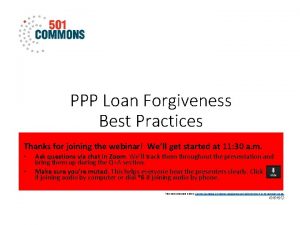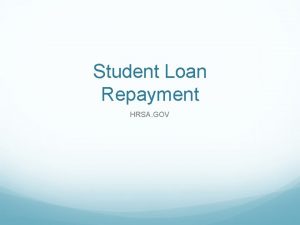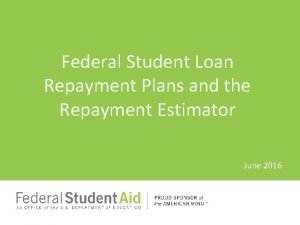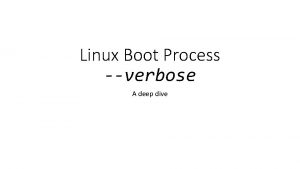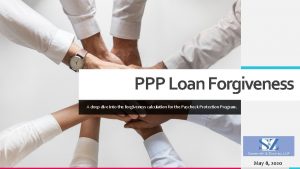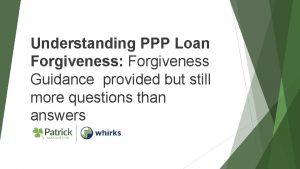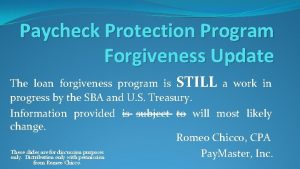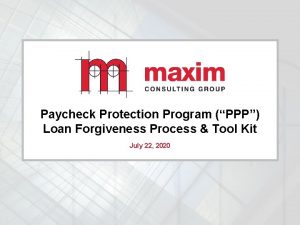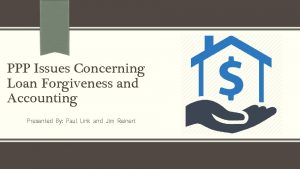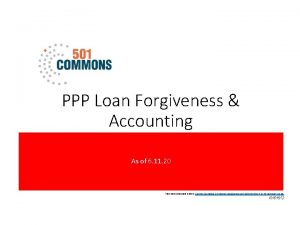PPP Loan Forgiveness A deep dive into the


















- Slides: 18

PPP Loan Forgiveness A deep dive into the forgiveness application for the Paycheck Protection Program. May 20, 2020

• Founded in 1997 by Alan R. Sasserath, CPA, MS and Gregory Zoraian, CPA • Accounting, tax and business advisory services to corporations, small businesses and individuals in Long Island, across the country, and around the world. • Tailored services to meet client specific needs. • Specialty areas include: • • • Financial Services International Tax Technology Companies Construction Service Industries About Us Our Long Island CPA firm believes that clients’ success determines our own. So we ensure both by collaborating with our clients to achieve their goals. TREY research 2

Alan started his career in the audit department of Ernst & Young prior to working in the tax departments of two large regional firms. In 1996, Alan started his own practice and subsequently joined with Gregory Zoraian in January 1997 to form Sasserath & Zoraian, LLP. He has 30 plus years of public accounting firm experience with a broad background in accounting, tax, audit and financial planning. Alan's technical experience includes working with high net worth individuals and closely held businesses, dealing with matters related to both domestic and international tax. His industry experience includes technology companies, real estate management companies, construction, printing as well as numerous service industries. Alan. R. Sasserath, CPA, MS Partner – Sasserath & Zoraian LLP TREY research 3

Webinar Overview TREY research 4

Paycheck Protection Program (“PPP”) Loan Forgiveness Amount Calculation Payroll and Nonpayroll Costs for 8 weeks - Salary/Hourly Wage Reduction - FTE Reduction - Payroll Cost 75% Limitation Forgiveness Amount TREY research 55

• Payroll Costs: Eligible payroll costs incurred OR paid during the Covered Period or the Alternative Covered Period. • Cover Period (“CP”): 8 -week period following the PPP Loan Distribution Date (The date that PPP loan funds are received by the Borrower). The first day of this period is the date the funds are received. • Alternative Payroll Covered Period (“APCP”): Available to Borrowers with a bi-weekly or more frequent payroll schedule. Starts on the first day of the first pay period following the PPP Loan Distribution Date. TREY research 6 6

Payroll Costs- Key Points, Comments, Questions 1. Payroll costs are considered paid on the day the paychecks are distributed or the borrower originates an ACH credit transaction. 2. Count payroll costs both paid and incurred only once. 3. Since it includes payroll paid, it appears that we can include unpaid payroll from prior periods. 4. Includes payroll costs incurred in the last pay period of the CP or APCP as long as they are paid no later than the next regular payroll date. 5. If you choose the APCP, then you must use this period for health insurance, retirement plan contributions and state and local income taxes assessed on employee compensation. Nonpayroll costs will be tracked based on the CP. 6. Paid or incurred. Paid and incurred. Paid. 7. Health insurance and retirement plan contributions – Employees only. No mention of Independent contractors, Proprietors and Partners in a Partnership. 8. Owner-employees, self-employed individuals or general partners compensation is limited to $15, 385 for each individual or the 8 -week equivalent of their applicable compensation in 2019, whichever is lower. 9. The $15, 385 ($100, 000 x 8/52) per employee cap is the cap for the CP or APCP. There is no reference to a per pay period cap. TREY research 77

Nonpayroll Costs: Key Points, Comments, Questions 1. Expenses must be either paid during the Covered Period or incurred during the Covered Period and paid by the next regular due date even if outside the Covered Period. 2. Includes mortgage interest on obligations incurred before February 15, 2020 on real or personal property. 3. Includes business rent or lease payments for real or personal property in force before February 15, 2020. 4. Included utilities are defined as business payments for a service for the distribution of electricity, gas, water, transportation (gasoline), telephone or internet access for which service began before February 15, 2020. TREY research 8 8

Full Time Equivalent (“FTE”) Reduction Calculation Average FTE Calculation for CP or APCP: • FTE is determined on an employee by employee basis. • For non-salaried employees, it is based on a 40 -hour work week then rounded to the nearest tenth. • Salaried employees are considered 1. 0 FTE. • There is a simplified method where you are permitted to use 1. 0 for employees that are salaried or worked at least 40 hours and 0. 5 for employees that worked less than 40 hours We also need to calculate FTE’s on an employee by employee basis for the following periods for nonseasonal employees: Base Period • 2/15/2019 -6/30/2019 • 1/1/2020 -2/29/2020 Safe Harbor • 2/15/2020 -4/26/2020 • 6/30/2020 Note: Seasonal employer requires additional period FTE calculations. Safe harbor calculations and reduction exceptions are available. TREY research 9 9

FTE Reduction Safe Harbors and Reduction Exceptions FTE Reduction Exceptions: • Any position where the Borrower made a good-faith, written offer to rehire an employee during the CP or APCP which was rejected by the employee; and • Any employees who during the CP or APCP: • Were fired for cause, • Voluntarily resigned, or • Voluntarily requested and received a reduction of their hours. Any FTE reductions in these cases do not reduce the Borrower’s loan forgiveness. FTE Reduction Safe Harbor: • If the Borrower’s FTE’s as of February 15, 2020 were higher than their FTE’s during the period February 15, 2020 – April 26, 2020, AND • whose FTE’s as of June 30, 2020 are restored to the February 15, 2020 FTE level, THEN • The safe harbor applies and no reduction in the forgiveness amount is required. TREY research 10 10

Salary/Hourly Wage Reduction Calculation • Applies to employees who during any single pay period during 2019 had wages or salary at an annualized rate of pay of less than or equal to $100, 000. • Based on reductions in total annual salary or average wages of an employee who during the CP or APCP had a reduction of more than 25% of their total salary or average wages when compared to the period January 1, 2020 – March 31, 2020. • We need to calculate annual salary or average hourly wages for each employee for the following periods for a nonseasonal employer: • 2/15/2020 -4/26/2020 • 1/1/2020 -3/31/2020 • CP or APCP Note: Seasonal employer requires additional period annual salary or average wages calculations. Safe harbor calculations are available. TREY research 11 11

Salary/Hourly Wage Reduction Safe Harbor (Calculated for all employees listed in PPP Schedule A Worksheet, Table 1): If an employee that either was not employed by the borrower or earned less than $100, 000 for all pay periods in 2019 and: • whose average annual salary or hourly wages were reduced by more than 25% during the CP or APCP when compared to the period January 1, 2020 through March 31, 2020, AND • whose average annual salary or hourly wages as of February 15, 2020 were higher than their average annual salary or hourly wages during the period February 15, 2020 – April 26, 2020, AND • whose average annual salary or hourly wages as of June 30, 2020 are restored, THEN • The safe harbor applies and no reduction in the forgiveness amount is required. TREY research 12 12

PPP Forgiveness Tool A discussion on the forgiveness calculation tool. TREY research 13 13

HEROES ACT-Signed May 15, 2020 by the House of Representatives (NOT LAW) • Extension of the covered period from June 30 to December 31 allowing the current 8 -week period from the date of PPP loan funding to be permitted to extend past June 30. • Repeal of the requirement that 75% of the loans be spent on payroll. • Clarification that expenses paid or incurred with proceeds from PPP loans that are forgiven are also deductible for federal income tax purposes. • Extends the 8 -week period to pay forgivable expenses to 24 weeks. • Establishes a minimum maturity on PPP loans of 5 years to enable borrowers to amortize loans over a longer time frame. • Extension of the eligibility to all nonprofits. • Allows payroll tax deferrals for recipients of forgiven PPP loans. TREY research 14 14

Self Employed Individuals TREY research 15

Questions? ? TREY research 16

Thank You Alan Sasserath 631 -368 -3110 alan@sz-cpas. com Sasserath & Zoraian LLP TREY research 17

This Power. Point presentation is provided by Sasserath & Zoraian, LLP and is intended solely for general informational and educational purposes. It is not intended in any way as financial, securities, insurance, tax or legal advice or services, or as a solicitation for any financial, securities, insurance, tax or legal product or service. Please consult with your financial, securities, insurance, tax and/or legal advisors for advice regarding your specific circumstances. The calculations herein are estimates based on our interpretation of the bill signed into law on March 27, 2020 under the CARES Act. TREY research 18
 Ppp loan forgiveness
Ppp loan forgiveness Dive deep synonyms
Dive deep synonyms Hrsa student loan forgiveness
Hrsa student loan forgiveness Nebraska teacher loan forgiveness
Nebraska teacher loan forgiveness Grub boot verbose
Grub boot verbose Timw warner
Timw warner Deep dive antonyms
Deep dive antonyms Azure cosmos db: sql api deep dive online courses
Azure cosmos db: sql api deep dive online courses Pears deep dive
Pears deep dive Deep dive icon
Deep dive icon Ppp loan list
Ppp loan list Oneill
Oneill 深哉深哉
深哉深哉 Deep asleep deep asleep it lies
Deep asleep deep asleep it lies Deep forest: towards an alternative to deep neural networks
Deep forest: towards an alternative to deep neural networks Dive physiology
Dive physiology Forsyth central swim and dive
Forsyth central swim and dive How to use recreational dive planner
How to use recreational dive planner Glycolyaia
Glycolyaia
